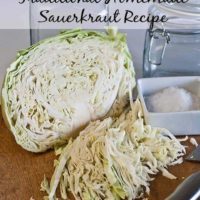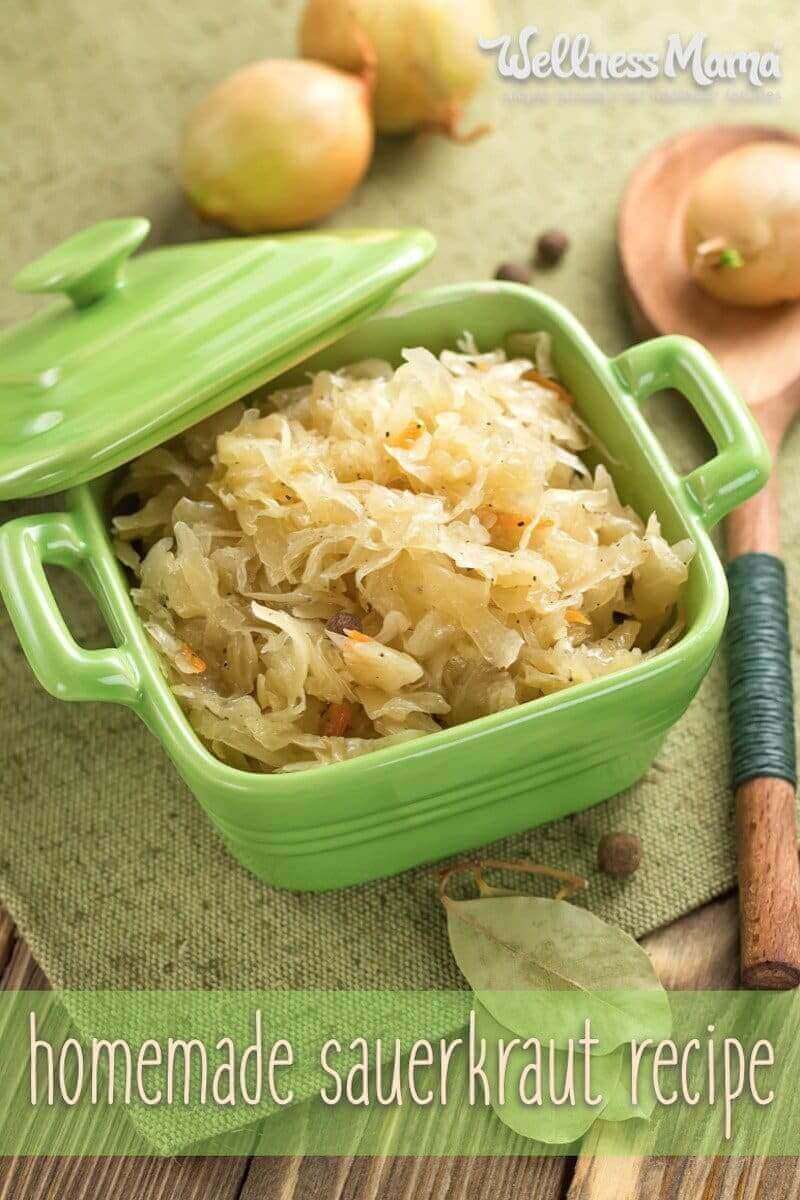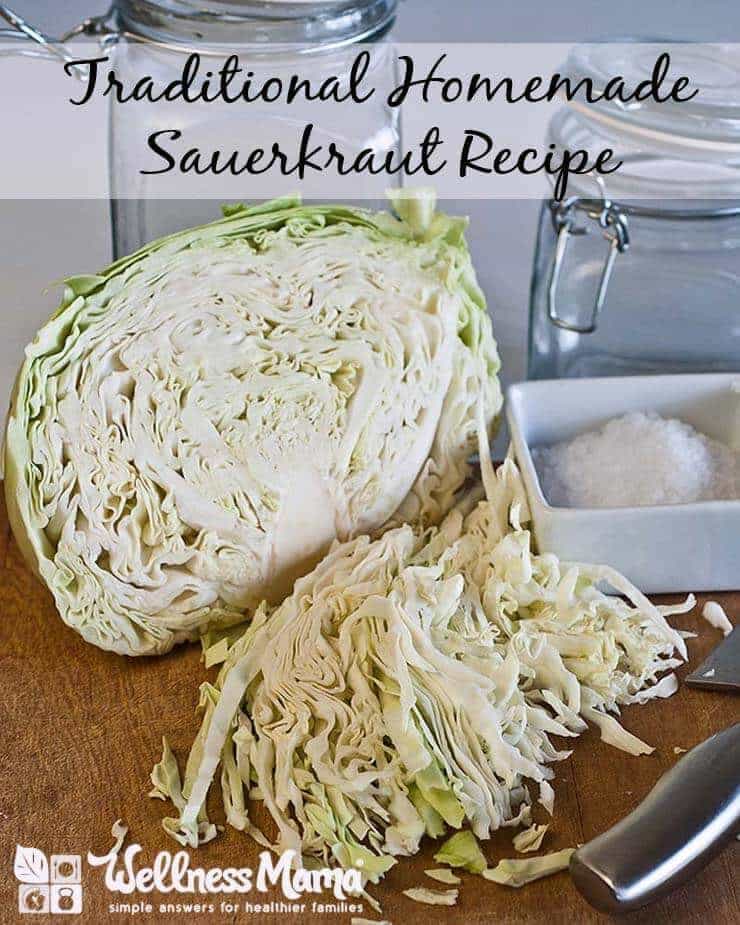Fermenting is an age-old way of preserving foods and increasing their nutritional value. Turning cabbage into sauerkraut is one of the easiest fermented foods to master.
Why is this sauerkraut better for you? During fermentation, billions of beneficial bacteria are produced. Because it’s homemade (and not pasteurized like in the store), this bacteria is still present when we eat it and helps our gut flora.
In fact, homemade sauerkraut is one of the least expensive and easiest ways to add probiotics to our diets!
Sauerkraut: Why Make It from Scratch?
In short, it is cheaper, healthier, and oh so much tastier!
Being the ¼ German that I am, I have always had a love of sauerkraut. The problem is, short of authentic German restaurants, good sauerkraut is hard to find. The logical solution, of course, was to make my own. Sauerkraut was the first thing I got brave enough to try to ferment, and it will always have a special place in my heart and on my counter.
Sauerkraut has all the benefits of traditional fermented foods, including the abundance of natural probiotics. It is made using natural lactic acid fermentation. In other words, beneficial Lactobacillus bacteria do the hard work of breaking down the cabbage into its delicious and salty final product.
Store-bought sauerkraut is often cooked, killing the beneficial bacteria. The few good brands, like Bubbies, are great, but expensive.
The Kraut-Making Process: Sauerkraut 101
Sauerkraut simply means “sour cabbage” in German, but making kraut does so much more than just make cabbage sour!
As I mentioned, the Lactobacillus bacteria are the active workers in the process. These bacteria occur naturally in fruits, vegetables, and even on our skin and in our bodies. They are generally considered harmless and even beneficial. Lactobacillus also have two major properties that make them perfect for fermentation:
- They can survive in an anaerobic environment (oxygen-free)
- They handle salt well, unlike many other types of bacteria
This allows us to ferment the cabbage under a brine in an oxygen-free environment without killing the Lactobacillus. Many other types of bacteria don’t handle salt or lack of oxygen well. The lactic acid fermentation process allows the good bacteria to stay and flourish while discouraging the bad bacteria.
If it sounds complicated so far, never fear … the recipe itself is a snap!
The Right Equipment Makes a Big Difference
Sauerkraut is tough to mess up, but the right equipment makes the process so much easier! Since kraut is one of the most budget-friendly real foods out there (along with sardines), I’ve found that it is worth investing in some inexpensive equipment to make it a regular part of my diet. There are several different methods to choose from.
Option 1: A Good Ol’ Mason Jar
The most basic method of sauerkraut-making is done in a simple glass jar. Even a quart-size mason jar will work, though many people choose a half-gallon size to be able to make a little more at once. You can use a plastic bag filled with water to seal the jar from air, though considering my feelings about plastic, I highly discourage this method. Instead, I recommend getting these pieces of equipment:
- Glass fermentation weights – These keep the cabbage under the water level of the brine, which protects the fermentation environment. This can also be done with a small glass jar filled with water or rocks, as long as it fits inside the larger jar.
- Fermentation Lids – There are a lot of options available for this. I personally have used and love these silicone fermentation lids. If you want a fancier lid these are slightly more pricey, but work really well.
Whichever equipment you pick, I encourage you to have some kind of weight and some kind of fermentation lid. You can also use this equipment when making kimchi and pickles!
Option 2: A Fermentation Crock
I prefer the more traditional method of making sauerkraut in a fermentation crock. For one thing, you get to use a cool-looking traditional stoneware fermentation crock (like this one). I find this method easier and a high-quality crock costs less than the weights, lids, and jars you need for the mason jar method.
If you aren’t sure you’ll love making sauerkraut, it might be best to start with the mason jar method. If you like it, a fermentation crock will greatly simplify the process.
How to Make Homemade Sauerkraut
A few tips for making the best homemade sauerkraut:
- Use the freshest cabbage available. Any color cabbage will work, but the fresher it is, the more crisp the finished sauerkraut will be. I love making kraut with fresh-picked cabbage from my garden or farmers market.
- Make sure everything is clean. Since this process relies on a certain type of bacteria for fermentation, it is important to remove as much unwanted bacteria as possible. No need to bleach anything (please don’t!), but make sure the jar or crock has been washed well in warm, soapy water, and wash your hands well too!
- Get rid of the air. As explained above, the beneficial bacteria need an anaerobic environment to ferment correctly. Using any of the methods I explained above will accomplish this.
- Get the salt right. This recipe does require salt. It is necessary not just for taste, but for proper and safe fermentation. I’ve tested it and it can be done with as little as 1 tablespoon per quart of sauerkraut (2 tablespoons total for this recipe), but doesn’t work well with less than that.
- Keep the temperature moderate. In my experience, kraut is best when fermented at around 64-67 degrees, though anything in the 60-70 degree range works well. If it gets cooler than that, fermentation is very slow. At higher than that, it is too fast and can yield a mushy finished product. Cabbage is often freshest in cooler months, and counter temperatures are perfect at these times. In warmer months, I often place kraut near air conditioning vents to keep it cool, or just make sure it is in a cool, dark corner of the pantry.
- Then make it stop! Once you’ve achieved the desired level of fermentation, it is important to move it to the refrigerator to stop the fermentation. At this point, it will store for up to 6 months if kept cool and with the kraut below the brine.

Homemade Sauerkraut Recipe
Servings
Ingredients
- 2 heads cabbage (about five lbs)
- ¼ cup salt (see note below)
- 1-2 TBSP caraway seeds (optional)
Instructions
- Get things clean – Wash all equipment, work surfaces, and your hands in warm soapy water.
- Slice the cabbage – Remove the outer leaves and cores from cabbage. (Compost them if you can!) Slice the cabbage into quarters for easier slicing. Then, thinly slice cabbage into very thin ribbons. If you have one, a food processor speeds up this process.
- Add the salt – Place the thinly sliced cabbage in a large bowl (make sure it is clean too!). Sprinkle the salt over it. Knead and squish the cabbage/salt with your hands for about ten minutes. At first, it won’t seem like it is doing anything at all, but be patient. After a few minutes, the cabbage will start releasing liquid and by the end, there should be enough liquid brine to cover the cabbage in the crock or jar. Add the caraway seeds at this point if you are using them.
- Move it to the fermentation vessel – Stuff the cabbage very tightly into the jars or fermentation crock. Pour any liquid from the bowl into the jar. If needed, add just enough water to make sure the water/brine covers the cabbage entirely. If the cabbage is fresh, no liquid may be needed, but don’t worry if you have to add a little water.
- Weigh and cover – Add the fermentation weights and fermentation seal (or use the fermentation crock as directed). If you are just using a basic mason jar, you can also do this by adding a smaller jar that just fits inside the lid of the mason jar and covering both jars with a cloth and a rubber band.
- Let it ferment – Now you get to practice patience! Fermentation will begin within a day and take 2-5 weeks depending on temperature and desired tartness. After 2 weeks, check for desired tartness. The sauerkraut is technically slightly fermented after only a few days, but the best flavor seems to be at the 2-3 week mark. Taste is the best measure here, so check it often and stop the ferment when you get the desired taste. Note: It is normal to see bubbles, white scum, or foam on top during the fermentation. You shouldn’t see any actual mold, though. If you do, scrape it off the top, and make sure all the rest of the cabbage is fully submerged. All cabbage below the brine level should still be fine.
- Cool it down – Once fermented, it can be eaten right away, or it will store in the refrigerator for up to six months.
- Enjoy! Sauerkraut is delicious on its own or added to salads, soups, or on top of meats.
Nutrition
Notes
Sauerkraut Health Benefits
Now that you’ve made some delicious kraut, you get to enjoy its many benefits. Sure, it’s delicious, but it also has some other nutritional benefits:
Probiotic Powerhouse
If high quality probiotics aren’t in the budget, just make some sauerkraut. It contains billions of naturally occurring beneficial bacteria. Probiotics are thought to be beneficial in supporting the natural balance of bacteria in the gut. Some studies even indicate that probiotics and gut health are important for mental health, digestive health, and proper immune function.
Vitamins B & C
Cabbage is a natural source of B vitamins and vitamin C. The process of fermentation increases the availability of these nutrients, potentially making sauerkraut more nutritious that the original cabbage itself.
Good for Digestion
Sauerkraut is included in protocols like the GAPS diet to seal and heal the gut. Many people report that sauerkraut soothes and helps improve their digestion.
Antioxidants
Sauerkraut is a good source of lutein and zeaxanthin. These antioxidants are well-studied for their benefits to the eyes.
Do you like sauerkraut? Ever tried to make your own? Share below!



Leave a Reply